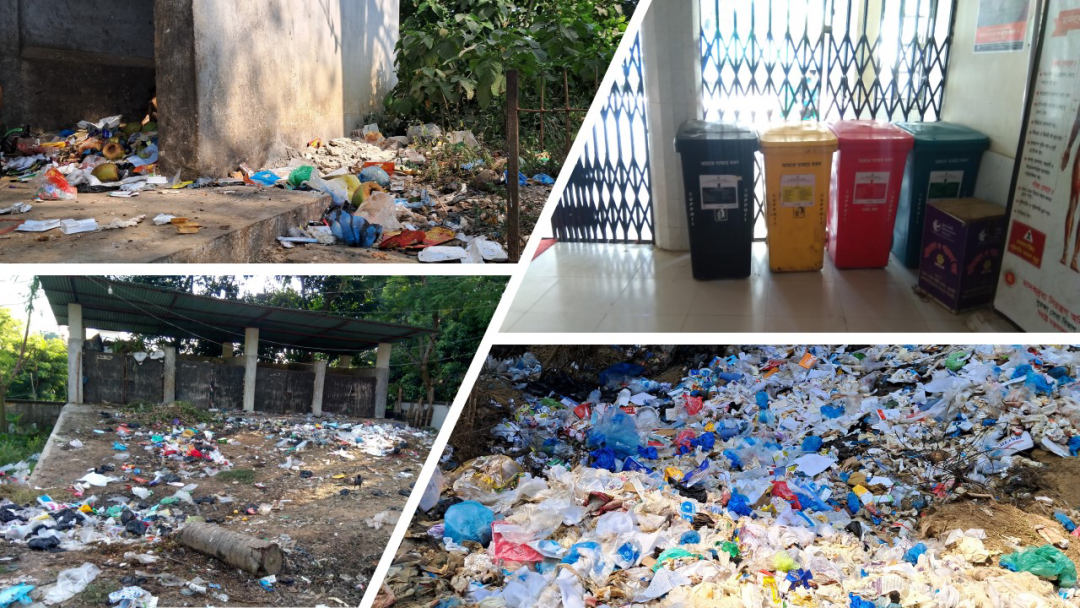Disclaimer:
Please be aware that the content herein has not been peer reviewed. It consists of personal reflections, insights, and learnings of the contributor(s). It may not be exhaustive, nor does it aim to be authoritative knowledge.
Title
Please provide a name for your action learning plan.
Connecting Healthcare and General Waste Management Ecosystem: Leading to Sustainable Governance Framework
Challenge statement
Challenge type: If you are working on multiple challenges, please indicate if this is your "big bet" or "exploratory" challenge.
Please note: we ask you to only submit a maximum of 3 challenges - 1x Big Bet, 2x Exploratory. Each challenge must be submitted individually.
EXPLORATORY
Challenge statement: What is your challenge? (Please answer in specific terms: "Our challenge is that...”.)
Our challenge is that there remains huge information and process gap in the ecosystem between the infectious and solid waste management in the hospital and municipality of CHT. Lack of awareness, skills, monitoring system, enough resources and appropriate coordination within the stakeholders fuel the challenges while making the system complex.
Background: What is the history of your challenge? What is causing or driving it? Who is involved? How does the current situation look like? What undesired effects does it produce?
On average, every day the 26 public hospitals (3 districts and 23 sub-districts) of Chittagong Hill Tracts in Bangladesh produce more than 3,120 Kg/day of waste. And there is no systematic way to manage infectious waste that is manually disposed of or treated inside or outside the hospital premises. Open disposal of infectious healthcare waste usually creates health hazards to waste workers and poses risks to human lives as well as other creatures. Hospital wastes are mixed up with general waste at the point of generation or in the pile of municipalities waste. Unprotected collection and transfer of hospital and municipalities waste usually create potential risk of further being infected or risk of accidental injury cases from sharp and infectious residues. Moreover, challenges exist in engaging local community and local stakeholders (Municipalities, private sectors, CSOs and the NGOs), no scope for knowledge management and international knowledge sharing (south-south cooperation), the lack of local waste management ecosystem by municipalities and the local government for landfilling outside the hospitals create major limitations that indicates to address further intervention. More importantly data insights and digitalization has been seen as a far-reaching obstacles for effective waste management in those areas. Alongside the hospital wastes, it is important to know the entire waste management ecosystem of the general waste carried out by the municipalities, which actually driving the demand for undertaking innovation and experimentation on the waste management ecosystem.
Quantitative evidence: What (official) data sources do you have on this challenge that better exemplifies the importance and urgency of this frontier challenge? You can add text, a link, or a picture.
Bangladesh has experienced increasing medical waste generation with estimated growth of 3% per year. The existing healthcare waste management in Bangladesh is far behind the sustainable waste management concept. To achieve an effective waste management structure, Bangladesh has to implement life cycle assessment (LCA) and circular economy (CE) concepts in this area. However, inadequate data and insufficient research in this field are the primary barriers to the establishment of an efficient medical waste management system in Bangladesh. The estimated generation of medical waste in Bangladesh without considering the surge due to Covid-19 and other unusual medical emergencies would be approximately 50,000 tons (1.25 kg/bed/day) in 2025, out of which 12,435 tons were predicted to be hazardous waste. However, our calculation estimated that a total of 82,553, 168.4, and 2300 tons of medical waste was generated only from handling of Covid patients, test kits, and vaccination from March 2021 to May 2022.
Link: https://www.sciencedirect.com/science/article/pii/S004896972300699X

Qualitative evidence: What weak signals have you recently spotted that characterizes its urgency? Please provide qualitative information that better exemplifies the importance and urgency of this frontier challenge. You can add text, a link, or a picture.
Studies found that 3 kinds of risk associated with the hazardous healthcare waste that are often mixed with the general waste of municipalities. It can cause occupational risk, public health risk, and indirect risk via the environment. Occupational risk can occur during handling of wastes. The health-care personnel and waste workers may come in contact with waste-if it hasn’t been packaged safely. Many injuries occur because of syringe, needles or other sharps that have not been collected in safety boxes, or because these have been overfilled. Also, contact with other infectious waste that has not been packaged or treated adequately may cause a risk. On landfills or waste dumps, waste recyclers or scavengers may come in contact with infectious wastes if the waste has been disposed of without prior treatment.
The reuse of syringes by the general public represents creating one of the greatest public health problems in the developing world related to health-care waste. Worldwide, an estimated 10 to 20 million infections of Hepatitis B and C and HIV occur annually from the reuse of discarded syringe needles without prior sterilisation. If health-care waste is dumped on un-controlled sites or in other areas, which the public can access, and in particular children can come in contact with infectious wastes. Also, the contact with toxic chemicals, such as disinfectants, may cause accidents when they are accessible to the public.
In addition to risks from direct contact with health-care waste, waste can also contaminate the environment, such as the water or the air and so indirectly impact on health. When wastes are disposed of in a pit that is not lined, the ground water may become contaminated. As the same ground water may be used as a resource for drinking water, wastes may indirectly impact on health via the water. If waste is burned or incinerated in an incinerator, which does not have an emission control (which is the case with the majority of incinerators in developing countries), the air may become contaminated by a large number of pollutants and cause serious illness in people who inhale this air.
Link: https://www.academia.edu/71254951/Hospital_Waste_Management_Bangladesh
Value proposition: What added value or unique value proposition is your Accelerator Lab bringing to solving this challenge? Why is it your Lab that needs to work on this challenge and not other actors within UNDP, other stakeholders in the country respectively? Why is it worth investing resources to this challenge?
Our lab will bring innovation in bridging the gap between IHWM and SWM ecosystem by connecting local hospitals and municipalities along with other stakeholders including civil surgeon, health convenor, doctor, nurse, ward boy, cleaners, private sector, pharmaceuticals, dispensaries, school/ college teachers and students, informal workers and local communities. Our lab needs to work on these challenges in order to develop a digitized healthcare waste management system in CHT where healthcare waste and solid waste data will be system generated. For effective evidence-based policymaking in healthcare sector, the ecosystem of IHW and general waste should be identified and for what the lab has relevant resources to work on this. Also, it is worth investing resources to behavioural change intervention as this could be one of the best ways to change people's mindset.
Short “tweet” summary: We would like to tweet what you are working on, can you summarize your challenge in a maximum of 280 characters?
Healthcare Ecosystem: Infectious Waste and General Waste Management at Last Mile
Partners
Who are your top 5 partners for this challenge? Please submit from MOST to LEAST important and state Name, Sector and a brief description of the (intended) collaboration.
Please state the name of the partner:
1. Local Administration (Municipalities)
2. DGHS
3. SID-CHT
4. Hospital Authority
5. Local Stakeholders
What sector does our partner belong to?
Private Sector
Please provide a brief description of the collaboration.
1. Local Administration (Municipalities) - Main actor in implementing the intervention and leading the connections between infectious and general waste management by engaging all other relevant stakeholders.
2. DGHS - providing technical and advisory support in developing the guidelines for infectious healthcare waste incorporating the ecosystem with general waste. They will also support in preparing national level database on all kind of healthcare waste countrywide.
3. SID-CHT - Implementing partners engaging local stakeholders and logistical support, organizing events (workshops and seminars)
4. Hospital Authority - Collaborating with municipalities and local communities in source segregation, awareness raising regarding infectious and general waste.
5. Local Stakeholders - Engaging local communities and integrating local solutions to the intervention.
Is this a new and unusual partner for UNDP?
No
Learning questions
Learning question: What is your learning question for this challenge? What do you need to know or understand to work on your challenge statement?
1. How to map connections between Infectious Healthcare Waste Management and Solid Waste Management to have a better picture of the existing ecosystem?
2. Who and what are the relevant actors and factors responsible for maintaining ecosystem between infectious and solid waste at CHT?
3. What is the existing mechanism of ecosystem between IHW and GW management in CHT?
4. How data innovation and digitalization in the ecosystem of infectious and general waste can improve the process of waste management?
5. How to develop a sustainable waste management ecosystem through a safe moving and management between infectious and general waste using a partnership model?
6. How behavioural insights can address the awareness of the infectious and solid waste among the local stakeholders
To what stage(s) in the learning cycle does your learning question relate?
Sense, Explore, Test
Usage of methods: Relating to your choice above, how will you use your methods & tools for this learning question? What value do these add in answering your learning question?
Relating to our choices, these methods and tools will be used to understand both the qualitative and quantitative context of infectious healthcare and general waste at hospitals and municipalities. We would use these tools to identify existing practices, challenges, partners, and inclusive solutions to the problem identified.
Existing data gaps: Relating to your choice above, what existing gaps in data or information do these new sources of data addressing? What value do these add in answering your learning question?
In our country, we lack systematic data on the volume of Healthcare (infectious, general) and municipalities (household, general) waste at national and local level. That usually hampers the management process of both healthcare and general waste ecosystem. The relating data sources would help in collecting the usable and relevant data on the quantity of waste, collection, separation, transportation, and disposal of waste at the marked places. Through data mapping, it would be possible to identify the relevant stakeholders and set workable mechanism to establish a sustainable ecosystem between infectious and general waste management.
Closing
Early leads to grow: Think about the possible grow phase for this challenge - who might benefit from your work on this challenge or who might be the champions in your country that you should inform or collaborate with early on to help you grow this challenge?
Since waste management is related to some of the SDG indicators and also in government priority, the government of Bangladesh will be able to make effective waste management guidelines at the health sector and for other general waste. Most importantly, the people at CHT and the waste management authority including waste workers would benefit from the system developed as it would reduce the percentage of being further infected by the infectious waste management. Through behavioural change interventions people as well as the local community including hospital and municipalities would be conscious of the ecosystem if healthcare and general waste management.
END OF ACTION LEARNING PLAN: Thank you! The form saves automatically and your submission has been recorded. You may now exit this window.



 3Good health and well-being
3Good health and well-being 11Sustainable cities and communities
11Sustainable cities and communities 12Responsible consumption and production
12Responsible consumption and production
Comments
Log in to add a comment or reply.